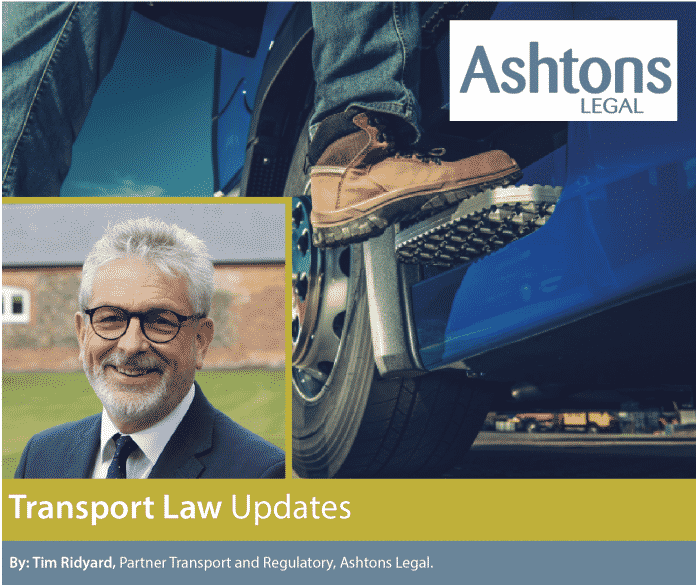There were a number of legal changes – and announced future changes in 2021 – and many, if not most, relate directly or indirectly to significant driver shortages and supply chain issues that are affecting the private and public sector at every level. These problems are likely to continue for some considerable time, writes Tim Ridyard of Ashtons Legal.
The underlying problem of driver shortages started long before Covid 19 and the current situation is a ‘cocktail’ of long, medium, and short-term problems:
- an ageing driver profile (very high proportion of mainly older, male drivers)
- attractiveness of the vocation: poor working conditions and unsocial hours
- training and access costs
- IR35 changes (from April 2021)
- HGV/PCV testing delays during Covid 19
- mass exodus of non-UK drivers post-Brexit, also departing for COVID-related reasons, who will likely never return
- lack of attraction to non-UK driver due to visas and driver status
The problems have exposed the absence of any coherent plan to tackle this issue. Now, various initiatives have been announced to address the driver shortage crisis that may or may not be effective in addressing what has been a fundamental problem for years.
HGV and bus/coach learning/testing
Staged licence testing will be changed to allow drivers to get a provisional licence for any trailer category and qualify in a one-stage process, if they so wish, so long as a Category B licence is already held.
From 15 November 2021 the Motor Vehicles (Driving Licences) (Amendment) (No4) Regulations 2021 make this possible:
- learn to drive/take test by going straight to Category CE without having to take the Category C test first in a two-stage process – this means one can obtain a provisional licence to learn both C and CE categories
- identical provisions for bus/coach drivers who can learn to drive/take test in Category DE without having to take Category D first
- lorries up to 7.5 tonnes and minibuses: this is similarly one process for C1E and D1E
No driver has to go through this one-stop process and can do this in stages as now (e.g. Category C then C1) if they wish. Some may prefer this to gain experience without trailers. No risk assessment appears to have been carried out as any possible adverse impacts of this, form a road safety point of view. It will mean a driver being able to drive the largest vehicles pulling trailers, without prior practical work experience.
Driver CPC will be affected – the driving ability test will be divided into two parts, as of 15 November 2021(tbc): there will be an off-road exercises test and an on-road driving test. DVSA will authorise training bodies to do the former but such a training organisation cannot carry out both the driver’s training and the test. The test will involve bay reversing and coupling/uncoupling procedures for trailers (for licences for trailers). The on-road driving test will comprise vehicle safety questions and 60 minutes practical on-road driving.
Car/Category B licences and trailers
Other proposals not yet scheduled to commence are changes affecting what can be driven under a Category B licence (under 3.5 tonnes) and this may assist some businesses operating vans and trailers, as well as private individuals towing horseboxes and caravans etc.
Whilst this initiative may well assist many businesses operating at lower weight bands, it has been more controversial from a safety point of view. Again, no risk assessment appears to have been carried out and part of its rationale was to free up examiners for testing other categories, just as the trailer changes outsources part of the test to external organisations to that end.
This Category BE entitlement will be automatically updated into the DVLA licence record and will appear on any new licence issued. This means that it will not be necessary to take a BE test and there is industry concern, with regard to the need for training in this area. HM Government advises that training be taken, but leaves this to individuals and businesses to address.
(NB – the BE trailer licence measures set out above were scheduled to commence on the 15th November 2021, but at time of publication the start date was not confirmed. This information should be checked, in case of any amendment.)
Review of HGV training (consultation)
On 8 November 2021 the Department for Transport announced it is intends to conduct a ‘sweeping review’ of Driver CPC training for ‘existing and returning HGV drivers. The issue here is the cost of Driver CPC training that may put off drivers entering or coming back to the sector, at a time when drivers are sorely needed.
DVLA medical questionnaires
A consultation has been commenced seeking view on allowing healthcare professions other than registered medical practitioners to complete DVLA medical questionnaires relating to drivers. Its purpose is to improve service, whilst not compromising health assessment for licensing – the average time for DVLA to receive medical information from doctors is currently 75 days for lorry and bus cases and 95 for car applications. The consultation closes on 6 December.
Drivers’ hours rules (relaxation)
The temporary relaxation on the enforcement of EU drivers’ hours rules in all road haulage sectors, that commenced during ‘lockdown’ and has been extended repeatedly, has now been further extended to 9 January 2022. They can only be applied if all the following apply:
- there is evidence of detriment to the wider community e.g. significant risks to the supply chain / human or animal welfare and acute food/fuel and medicine shortage
- using the relaxation will significantly improve the above
- no compromising of driver safety
The extent to which these relaxations have actually been used is uncertain, given it is not straightforward to apply and industry concerns about extending further already long shift patterns.
The Government position is that: “Driver safety must not be compromised. Drivers should not be expected to drive whilst tired – employees remain responsible for the health and safety of their employees and other road users”. So, employers are allowed to apply the relaxations – but only if this is safe – despite the standard Drivers’ Hours Rules supposedly being regarded as being the safe maximum driving and minimum rest periods.
In essence, the daily driving limit can increase from nine to 10 hours (and 11 hours once per week); as an alternative, weekly rest patterns can be amended.
It is intended to be applied “through agreement between employers and employees and driver representatives”. Drivers have to record why they are deviating from the normal limits. Further, businesses have to notify the Department for Transport if they deploy the relaxations on a prescribed form, at the start and after the relaxation period.
There continue to be clear health and safety issues being flagged up about these drivers’ hours relaxations, where drivers may be facing even longer shifts, driving large goods vehicles that require the high skills and levels of concentration. Operators will need to think through whether increased hours sits comfortably with their overarching health and safety objectives and compliance. They will need to assess the risk.
The Department for Transport sets out its changes as follows:
Relaxation of EU drivers’ hours rules
The retained EU drivers’ hours rules can be temporarily relaxed as follows.
The replacement of either:
- the permitted increase to the daily driving limit from nine hours to 10 hours with one of 11 hours (allowed up to twice in one week)
- the requirement to take a regular weekly rest period of 45 hours in a two-week period with an alternative pattern of weekly rest periods as specified below, and an increase to the fortnightly driving limit from 90 hours to 99 hours. This enables two consecutive reduced weekly rest periods to be taken
The alternative pattern of weekly rest periods for drivers using the relaxation related to weekly rest periods is as follows:
- the regular weekly rest period in a two-week period can be replaced by two reduced weekly rest periods of at least 24 hours
- following this, two regular weekly rest periods must be taken. However, any reduction in weekly rest shall be compensated for in the normal way by an equivalent period of rest taken before the end of the third week following the week in question
- in addition, any rest taken as compensation for a reduced weekly rest period shall be attached to a regular weekly rest period of at least 45 hours (which can be split over two regular weekly rest periods)
This relaxation must not be used in combination with existing rules for international driving, which allow for two consecutive reduced weekly rest breaks in certain circumstances.
It is not recommended this relaxation be used for drivers engaged partly in international journeys.
Changes to drivers’ hours rules 2020
Last year some changes were made to the EU rules that may have ‘floated under the radar’ for many businesses. These changes came about via Regulation EU 2020/10454 introduced on 20 August 2020 – they now allow a driver to exceed his or her daily and weekly driving time, but only in certain circumstances.
Previous law
Under Article 12 EU Regulation 561/2006 a driver was (and still will be) permitted to depart from the rules on daily driving time, weekly driving time, the 90-hour two-week driving limit, rests and ferry rests “to the extent necessary to ensure the safety of persons, of the vehicle or its load”…
1. so long as road safety is not jeopardised, and
2. to enable the vehicle to reach a suitable stopping place.
In order to qualify for any relaxation under this rule, the driver must record manually on the tachograph chart of a digital print out (or on a duty roster) the reason for this – and this must be done at the latest on arrival at the suitable stopping place. If this recording requirement is not complied with, then the relaxation simply does not ‘engage’ or apply so, rest / driving time offences will have been committed if the normal maximum limits are exceeded.
The new law from August 2020 – exceeding daily/weekly drive time
The following further relaxations are now possible, again ‘provided that road safety is not thereby jeopardised and in exceptional circumstances’:
- to exceed daily and weekly driving time by up to one hour in order to reach the operating centre or the driver’s place of residence to take a weekly rest period (NB either type of weekly rest)
- to exceed daily and weekly driving time by up to two hours so long as an uninterrupted break of 30 minutes is taken immediately prior to the additional driving, again to reach the operating centre or the driver’s place of residence, to take a regular weekly rest period. (NB – applies only to regular weekly rest).
It should be noted that this is only ‘in exceptional circumstances’ and hence cannot be routinely used as a means to circumvent the normal rules.
This applies to daily driving time, weekly driving time and daily rest periods.
The driver must still manually record this on the tachograph chart or digital printout at the latest on arrival at the destination or the suitable stopping place. NB a failure to do this renders it impossible to claim the relaxation from the outset.
(NB – Where any period has been extended it has to be compensated by an equivalent period of rest attached to any other rest period by the end of the third week following the week in question.)
So, the effect of all this is that the existing ability to reach a stopping place remains, to ensure the safety of persons/vehicles/load. However, it was from August 2020 extended in exceptional circumstances for the purpose of drivers reaching the operating centre (“the operator’s operation centre”) or the driver’s home for weekly rest purposes.
For further information please contact:
Tim Ridyard, Partner Transport and Regulatory T: 01284 732111 E: Tim.Ridyard@ashtonslegal.co.uk or visit: www.ashtonslegal.co.uk
Published in Essential Fleet Manager Issue 7 2021
Read it here https://issuu.com/jdmweb/docs/essential_fleet_manager_-issue_7?fr=sZWM0ZjQxNDIwNTE




